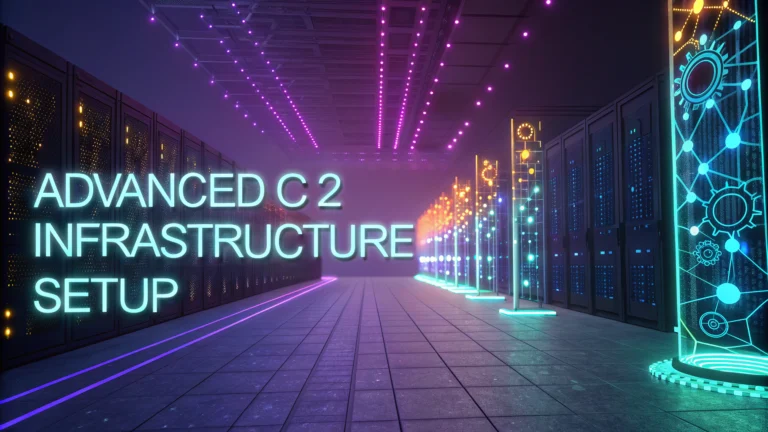Setting up an advanced command and control (C2) infrastructure requires careful planning and implementation of secure communication channels between compromised systems and control servers.
Understanding the components of C2 infrastructure helps penetration testers assess security postures and identify potential vulnerabilities in client networks.
This article outlines key steps for configuring C2 infrastructure while following industry best practices and maintaining operational security.
Core Components
- Redirectors to mask true C2 server location
- Domain fronting capabilities
- Malleable C2 profiles
- Multi-stage payload delivery
- Encrypted communications
Infrastructure Setup Steps
1. Server Configuration
Deploy Linux servers (preferably Debian/Ubuntu) with hardened configurations on reliable cloud providers.
2. Domain Registration
Register domains through privacy-protected registrars and implement rotating domains to avoid detection.
3. SSL/TLS Implementation
Install valid SSL certificates from trusted providers like Let’s Encrypt to encrypt C2 traffic.
4. Traffic Redirectors
Set up Apache/Nginx redirectors to forward specific traffic patterns while dropping suspicious requests.
Common C2 Frameworks
- Cobalt Strike
- PowerShell Empire
- Metasploit Framework
- Covenant
- Merlin
Security Considerations
- Implement strict firewall rules
- Regular rotation of infrastructure components
- Monitoring for signs of detection
- Proper access control and authentication
Operational Tips
Use separate infrastructure for different operations to maintain client separation.
Implement logging and monitoring to track C2 activities and detect potential compromises.
Maintain backups of configurations and encryption keys in secure offline storage.
Going Forward
Regular testing and updates of C2 infrastructure components help maintain operational effectiveness while reducing detection risks.
Contact reputable penetration testing firms or security consultants for professional guidance on C2 infrastructure implementation.
Additional Resources
- Offensive Security – Training and certification
- Rapid7 – Security tools and research
- Hack The Box – Practice environments
Traffic Management
Implementing proper traffic management ensures reliable C2 communications while avoiding detection. Key considerations include:
- Load balancing across multiple servers
- Traffic shaping to mimic legitimate patterns
- Jitter and delays in beacon timing
- Bandwidth throttling to avoid suspicious spikes
Payload Delivery
Initial Access
Design modular payloads that can adapt to different environments and security controls. Implement staged delivery to minimize detection surface.
Persistence
Establish multiple persistence mechanisms while maintaining stealth:
- Registry modifications
- Scheduled tasks
- Service creation
- WMI event subscriptions
Detection Avoidance
- Regular profile modifications
- Dynamic DNS resolution
- Protocol tunneling
- Memory-only operations
- Anti-forensics techniques
Maintaining Operational Resilience
Establish redundant communication channels and backup infrastructure to ensure continuous operations. Document all configurations and maintain secure deployment procedures for rapid recovery.
Regular testing of failover systems and backup procedures validates infrastructure reliability. Keep infrastructure components updated and implement security patches promptly.
Success in C2 operations depends on careful planning, proper implementation, and continuous maintenance of secure infrastructure components while adapting to evolving security landscapes.
FAQs
- What is C2 infrastructure in penetration testing?
A Command and Control (C2) infrastructure is a framework that enables security professionals to control compromised systems and manage communication between attack infrastructure and target systems during authorized security assessments. - What are the key components of a C2 infrastructure?
The essential components include teamservers, redirectors, domain fronting systems, command servers, payload hosting, and operational security mechanisms that help maintain persistent access while evading detection. - How can I implement proper OPSEC in C2 infrastructure?
Implement proper SSL/TLS certificates, use domain fronting, employ rotating IP addresses, utilize traffic tunneling, implement robust logging, and maintain separate infrastructure for different operations. - What are common C2 frameworks used in penetration testing?
Popular frameworks include Cobalt Strike, Empire, Metasploit, Covenant, Merlin, and PoshC2, each offering different capabilities for various testing scenarios. - How do I set up secure redirectors for C2 traffic?
Deploy HTTPS redirectors using tools like Nginx or Apache, implement proper SSL/TLS configuration, use CDNs for traffic obfuscation, and maintain separate redirector nodes for different C2 channels. - What are the best practices for C2 payload delivery?
Use staged payloads, implement proper encryption, utilize different delivery methods (DNS, HTTPS, SMB), employ sleep timers, and implement jitter to avoid detection. - How can I ensure my C2 infrastructure remains undetected?
Use legitimate-looking domains, implement proper SSL certificates, use domain fronting, employ traffic blending techniques, utilize sleep timers, and regularly rotate infrastructure components. - What are the common mistakes in C2 infrastructure setup?
Common mistakes include using default configurations, failing to implement proper SSL, neglecting logging mechanisms, reusing infrastructure across operations, and inadequate network segmentation. - How do I handle C2 infrastructure monitoring and logging?
Implement comprehensive logging systems, use secure log shipping, maintain separate logging infrastructure, implement proper log rotation, and regularly audit access logs. - What are effective C2 communication protocols?
Effective protocols include HTTPS, DNS, SMB, and custom protocols that blend with legitimate traffic patterns while maintaining operational capabilities.







